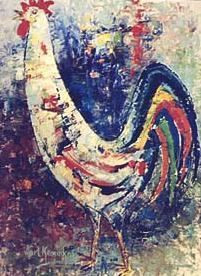Name Aart Kemink Role Artist | Died 2006 | |
 | ||
Aart Kemink (May 30, 1914, Rotterdam – 2006, Toronto, Canada) (variant names Arie Kemink, Art Kemink) was a Dutch-Canadian painter.
Kemink studied at Amsterdam's Rijksakademie van Beeldende Kunsten (in English: Royal Academy of Visual Arts). After his studies, he shared a studio with the Dutch graphic artist M.C. Escher in the late 1940s, and - in the early 1950s - became a member of the Beroepsvereniging van Beeldende Kunstenaars (known as the BBK or, in English, Union of Visual Artists). During his time in the Netherlands, Kemink also worked with compatriot artist Karel Appel, best known for his involvement in the Danish-Belgian-Dutch CoBrA movement. In 1957, Kemink participated in an exhibition of artists working for the theatre and circus at Amsterdam's nonextant Fodor Museum. While the artist held his own among Amsterdam and Rotterdam's artistic elite (a disparate group that included Piet Mondrian, Anton Rooskens, Corneille, and Eugène Brands), Kemink's reluctance to adopt a style or affiliate with a movement shielded his work from what he considered banal trends in Modern and Post-Modern Dutch painting.
Kemink emigrated to Canada in 1958, first settling in Brandon, Manitoba, then finally in Toronto, Ontario. He eventually became a Canadian citizen.
Kemink's oeuvre is largely abstract and tangentially influenced by the work of Marc Chagall and Willem de Kooning. Much of his work of the 1940s and 1950s was affected by World War II and the deleterious effects of the Nazi presence in the Netherlands. During the war, Kemink fought for the Dutch resistance. As a result of his efforts and abilities, he was later commissioned by the City of Amsterdam to produce a series of gouaches depicting the city's old Jewish quarters and the tragedy of their destruction (see Holocaust in History of the Jews in the Netherlands).
While bucolic representations of Kemink's native the Netherlands figure prominently in his work, the swathes and swatches of colour found in his abstractions - a possible result of his contact with Appel - dominate his mature work of the last quarter of the twentieth-century. The artist's rarefied palette calls to mind the colour signatures of Chagall, Raoul Dufy, and André Derain, while concomitantly evincing a new force in European émigré Canadian painting.
Despite a paucity of writings about his life or work, Kemink's paintings are highly valued by private collectors in Canada, the United States, and Europe. The artist's work was and continues to be represented in Canada by Maurice Amar, curator of Toronto's Laurier Gallery. It is difficult to gauge the market value of his paintings since they are rare and seldom sold at auction. Kemink's best pieces, however, have been praised and coveted by the National Gallery of Canada, the Art Gallery of Hamilton, Toronto's Consulate General of the Netherlands, and art collector Kenneth Thomson. His artistic achievement holds an important place in the history - beginning with Cornelius Krieghoff in 1840 - of Dutch painting in Canada. Kemink's foreign roots, however, as with those of myriad other artists, became indelibly marked by Canada's passive but persistent influence on the psyche. Despite a career pockmarked by relative obscurity, the quality and significance of Kemink's oeuvre is beginning to come to the fore.
